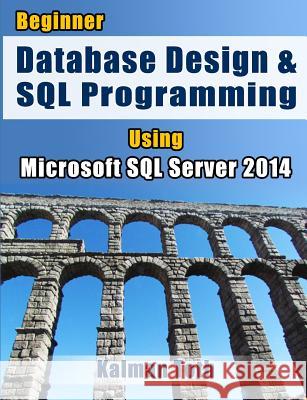Beginner Database Design & SQL Programming Using Microsoft SQL Server 2014 » książka
Beginner Database Design & SQL Programming Using Microsoft SQL Server 2014
ISBN-13: 9781499321739 / Angielski / Miękka / 2014 / 608 str.
Live the American dream Earn from $100,000 to $200,000 as a database expert. Learn Microsoft Database Design & SQL Server 2014 Programming SQL Server 2014 follows just in 2 years after SQL Server 2012 with very exciting new features. One on the top: in-memory OLTP tables for superior performance. With abundant computer memory, why keep tables on slow disk? Developers across the world face database issues daily. While immersed in procedural languages with loops, RDBMS forces them to think in terms of sets without loops. It takes transition. It takes training. It takes experience. Developers are exposed also to Excel worksheets, or spreadsheets, as they were called in the not so distant past. So, if you know worksheets, how hard can databases be? After all, worksheets look pretty much like database tables, don't they? The big difference is the connections among well-designed tables. A database is a set of connected tables, which represent entities in the real world. A database can be 100 connected tables or 3000. The connection is very simple: row A in table Alpha has affiliated data with row B in table Beta. However, even with 200 tables and 300 connections (FOREIGN KEY references), it takes a good amount of time to become familiar to the point of having an acceptable working knowledge. "The Cemetery of Computer Languages" is expanding. You can see tombstones like PL/1, Forth, Ada, Pascal, LISP, RPG, APL, SNOBOL, JOVIAL, Algol - the list goes on. For some, the future is in question: PowerBuilder, ColdFusion, FORTRAN and COBOL. On the other hand, SQL is running strong after 3 decades of glorious existence. What is the difference? The basic difference is that SQL can handle large datasets in a consistent manner based on mathematical foundations. You can throw together a computer language easily: assignment statements, looping, if-then conditional, 300 library functions, and voila Here is the new language: Mars/1, named after the red planet to be fashionable with NASA's new Mars robot. However, can Mars/1 JOIN a table of 1 million rows with a table of 10 million rows in a second? The success of SQL language is so compelling that other technologies are tagged onto it like XML/XQuery, which deals with semi-structured information objects. In SQL you are thinking at a high level. In C# or Java, you are dealing with details - lots of them. That is the major difference. Why is so much of the book dedicated to database design? Why not plunge into SQL coding and eventually the developer will get a hang of the design? Because high-level thinking requires thinking at the database design level. A farmer has six mules. H how do we model it in the database? We design the Farmer and FarmAnimal tables, and then connect them with FarmerID FOREIGN KEY in FarmAnimal referencing the FarmerID PRIMARY KEY in the Farmer table. What is the big deal about it? It looks so simple. In fact, how about just calling the tables Table1 and Table2 to be more generic. Ouch Meaningful naming is the very basis of good database design. Relational database design is truly simple for simple well-understood models. The challenge starts in modeling complex objects such as financial derivative instruments, airplane passenger scheduling, or a social network website. When you need to add 5 new tables to a 1000 table database and hook them in (define FOREIGN KEY references) correctly, it is a huge challenge. To begin with, some of the five new tables may already be redundant, but you don't know that until you understand what the 1000 tables are really storing. Frequently, learning the application area is the biggest challenge for a developer when starting a new job. The SQL language is simple to program and read even when touching 10 tables. Complexities abound though. The very first one: does the SQL statement touch the right data set - 999 records and 1000 or 998?
Zawartość książki może nie spełniać oczekiwań – reklamacje nie obejmują treści, która mogła nie być redakcyjnie ani merytorycznie opracowana.











